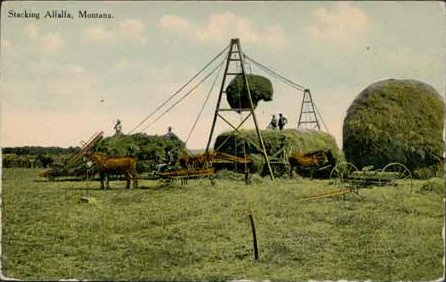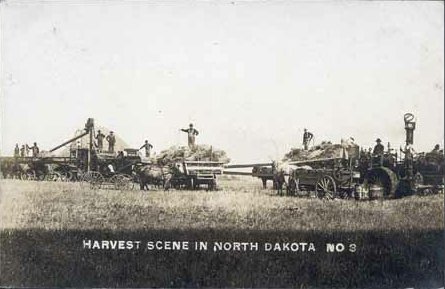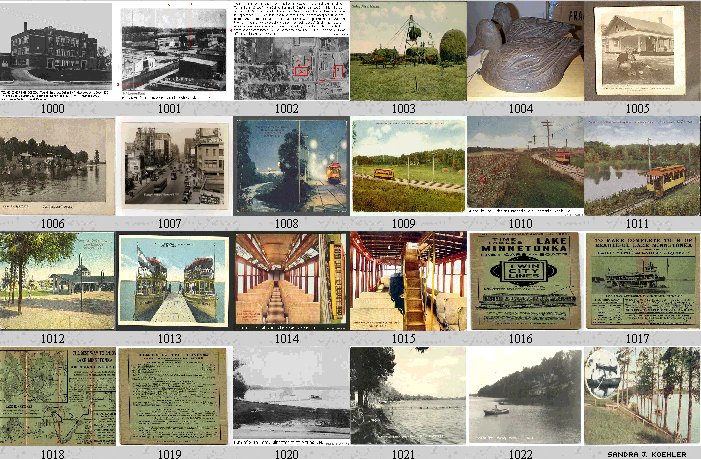When and What:
Probably pre 1930's ... I got carried away on this one... This has become
a web site itself. I just need more pictures. I was going to remove most
of it but as a vast number of the citizens of Greater Mound historically
were farmers I left it. Also there is an entire generation now that has no
idea of how people still living among them existed just decades ago.
The specific date is not certain, but because it is colorized black and
white it is probably from a time between 1890 and 1930. This scene could
have been witnessed long before that however. Of course it says
"Stacking Alfalfa in Montana", and not in Mound. The farmers around Mound
raised livestock and grew alfalfa, and several times a year went through
this same process. You would have witnessed this same scene many times if
you lived in Mound before World War 2. The statistical odds are best that
not only would you have been a "witness" but probably an unwilling
participant as well. (because your parents were most likely to have been
farmers).
While "tractors" and other mechanized equipment were available decades
before, many farmers in America could not afford "powered" machines like
tractors, and therefore relied on work horses, and strong children until
after the great depression of the thirties. The productivity gained by war
caused most of that to change in the later half of the 1940's. Before the
war you may have contracted a power equipt farmer to use his "threshing"
machine to process your grain once a year, but that type of thing was
usually the extent of mechanized farming for the average family farmer.
Most Americans lived on farms and the vast majority of these were
considered subsistance operations where everyone worked full time to
produce a meager living from the farm.
Animals were raised and food was grown both for the animals and the
farmers family. In Minnesota most of what you did was in some way a
preparation for the coming winter. After a spring of plowing and planting
and a summer of cultivating, you had to process and store your food by
canning, or drying it, and storing some of it in your root cellar. A root
cellar was like a room underground where you would store food in bulk.
Most of what you put into the root cellar came from your huge vegetable
garden and from barter with your neighbors. You had to fill your pantry
(usually a separate room full of shelves adjacent the kitchen) with
everything you would need until the harvest season of the next year.
This meant that the farmer's family spent a large amount of time and
effort in canning and otherwise preparing food in bulk quantities.
For your animals you had to fill the empty granary, fill the cribs with
corn, the loft with hay, and the silos with yes ... "silage". You were
always repairing the fences and the buildings. You had to cut many cords
of fire wood, sometimes with two man saws, then axes, wedges and sledges,
forget chain saws. This you would use for your cook stove and heat during
the cold Minnesota winter. Some things you would buy in town, matches,
coffee, salt, sugar, flour and other things a typical Mound area farmer
didn't produce. Many things you didn't buy because they didn't have "it".
If they did, and it was in the late 20's or 30's maybe you would buy it
from the clerk Patty Andrews or one of her sisters, Laverne or Maxine*,
at Pete Sollie's grocery store in down town Mound, but most things you
would produce at home.
* The "Andrews Sisters" became the biggest female musical act of the pre
Rock era. Boogie Woogie Bugle Boy, Rum and Coca Cola, Don't sit under the
apple tree, etc
You had to make most of the things you used, including baked goods, bread,
pies, cakes and all that other good stuff without any packaged mixes.
Quilts, curtains, table cloths, pillow cases, shirts and most other
things "cloth" were made at home, often from fabric grain sacks which
came in many types of patterns and colors just for this purpose.
When the farmer would go the mill or feed store to get extra
grain his wife would usually tell him what types of cloth she was
looking for and he would have to make sure he bought the "correct"
grain. These sacks are not to be confused with "gunny" sacks which
were usable for many things but wouldn't make very good pillow cases.
Many of the things you didn't make yourself you had to have the skills
to repair.
 |
A farmer might have an ice box if he had access to an ice house, other
wise he probably didn't. Ice houses were fairly common in Minnesota
because of all the lakes. Ice would be cut by hand into large blocks
which would be hauled to a large well insulated barn type bulding for
use in the summer. Blocks of ice could be used in an ice box if you had
one, and a special occasion or other reason to spend scarce money on such
things. Forget things like refrigerators and other appliances because most
farms didn't have electricity until World War II.
Yes it's hard for many people to believe but the majority of Americans did
not live in cities, they lived on farms, and the majority of those did not
have electricity until World War 2 through the efforts of the REA (Rural
Electric Association). Most service consisted of nothing more then one
incandescent light bulb in the barn or hen house. The farmers didn't
"want" electricity so the REA used the marketing technique of telling
the farmer that an electric lamp in the barn will cause the cows to give
more milk or the hens to lay more eggs which will mean more surplus to
sell. After a year or two with a light in the barn the farmers wife, for
whom life was very difficult, would have it brought into the house whether
the farmer liked it or not.
No electricity meant that if you had a radio it was either a crystal set
which was powered by the actual radio waves recieved, or you used a battery
power set which used large "tennis ball can" sized dry cell batteries .
This meant you only used it at special times because batteries were
expensive.
If you were modern enough to have a rural telephone it was on a shared
line with all your neighbors (party line) and driven by electricity from
the main telephone exchange in Mound. You had to use a crank driven
magneto in the phone to "ring" the operator first so that you could be
manually connected to whom ever you wanted to speak. (The operator would
ring their phone.) Then you could have a conversation with all your
neighbors silently listening in. When you reached the operator she (it was
always a "she") would ask "Number please", and you would recite the number
you wanted. The phone numbers were usually made up of 3 numbers and a
letter like 725M, 836J, 809W and so on. Long distance calls were usually
pre arranged and you were called back when the called party was reached.
This was achieved by a long chain of operators over the long distance
having you plugged in on their manual switch boards from the previous town
to the next. One inattentive operator and you were cut off. If you got a
long distance call it was almost always very bad news, that couldn't wait
for the rural delivery. (mail)
Without electricity you didn't even have an electric pump to push water
into a pressure tank providing you with running water. All rural sinks
were equipped with a large hand pump which had a long handle on it you
would move up and down rapidly until water was drawn out of a large
crockery, or concrete lined brick "jug" maybe 10 feet across buried under
ground called a cistern. The cistern was filled with water through many
means including windmills drawing from wells, and sometimes even rain. You
always had to save a little water for "priming" the pump so it could draw
water again the next time. This was accomplished by dumping a cup of water
into the pumps spout and then pumping like crazy until moving the handle
would become hard to do and water would flow out. If the pump didn't
"prime" you had to find more "clean" water to put in it. Not saving some
water and then mis priming the pump was one of the many now obsolete
things that siblings used to be able to "fight" about. Many farm house
kitchens had a trap door that gave one direct access to the cistern, you
could lower a cup on a string to get more water but you had to be careful
not to fall into it. Siblings could also fight over who tried to "push"
who.
Without electricity for running water you also had no indoor toilet which
was a joy (sarcasm) when it was 40 below zero with a 50 mile per hour wind,
and six feet of snow drifting. This is why farmers considered the chamber
pot up there with the wheel as one of the great inventions of history.
You used manually chopped wood for heat, with no thermostatically
controlled electronic ignition on the wood stove, (you of course used
"farmer" matches now called stick, or kitchen matches) so those very dark,
very cold rural Minnesota winter nights could be unpleasant. The oil
burning space heater was eventually used to supplement wood heat in most
farm houses because you didn't need to keep getting out of bed just to
throw more wood on the fire, or waiting to see how cold it could get before
someone else (farmer's wife) would do it. Having such modern conveniences
made you more appreciative of your ancestors who for millennia didn't have
the luxuries you have on your modern farm. Ancestors who worked like dogs,
and suffered all of their short lives, yet maintained their virtue.
Climbing so close to the heater that it would be burning your cheeks while
your back was freezing, you'd wish your ancestors could be there to enjoy
it's warmth . Curled up like a cat next to an oil stove, as the wind howls
like a wolf outside, what could be better than that?
Very often you would be out tending the animals if it was that cold.
Forget milking machines... they're electric. The winter was the only
time people didn't mind hand milking because their fingers were
"agonizingly numb" and frozen but the cow was warm. The cows weren't
always pleased with the cold hands though, you "might" even say they
were udderly displeased. (Ok, I have no self control.)
The animals never went on vacation, (nor did the farmer) the farm work
never ended. Everything was done the hard way, and if you did it the
'easy' way, it was still hard. After staying up all night milking,
hauling freezing buckets of water (you had to break ice to get) and frozen
fodder to the cows and other animals, you could go (often by foot) to Mound
High which 'never' closed for snow or cold, and "hope" you could learn
something. Of course sitting next to the large cast iron radiators of old
Mound High's hot water heat system, basking in its warmth, you would have
to be super human not to doze a little. ........... sorry about that, I
forgot I am not writting a book here.
This page is for the old farmers of the Mound area... where ever they are.
|






 Page #
sjka1003
Page #
sjka1003



















